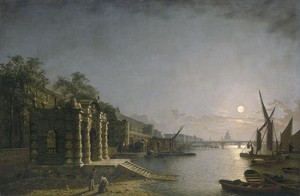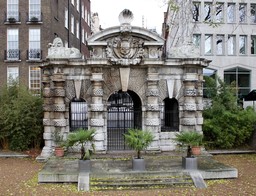River transportation in London
River Transport in London
The river was an important aspect of transportation in London in the 18th century, especially when roads around the city were often in poor condition and congested. There were some private boats, but most people hired one rather like a taxi, and Thames watermen had a monopoly. A boat could only pass through London Bridge at full tide, and even then it could be hazardous.
The river was mostly lined with buildings, but in many places stairs led along an alley between buildings allowing passengers to disembark and get to their destination.
By the mid 18th century fashionable dwellings had moved away from the river to Soho and Mayfair, but some great houses were still there and had private steps.
There's a bit more at London Online.
Public stairs in use on the River Thames early 1700s [from Wikipedia]:
"In 1746 the surveyor and cartographer John Rocque published a map of London that listed the main stairs and docks then in use on the Thames. On the London side of the river, going up stream:
The river was an important aspect of transportation in London in the 18th century, especially when roads around the city were often in poor condition and congested. There were some private boats, but most people hired one rather like a taxi, and Thames watermen had a monopoly. A boat could only pass through London Bridge at full tide, and even then it could be hazardous.
The river was mostly lined with buildings, but in many places stairs led along an alley between buildings allowing passengers to disembark and get to their destination.
By the mid 18th century fashionable dwellings had moved away from the river to Soho and Mayfair, but some great houses were still there and had private steps.
There's a bit more at London Online.
Public stairs in use on the River Thames early 1700s [from Wikipedia]:
"In 1746 the surveyor and cartographer John Rocque published a map of London that listed the main stairs and docks then in use on the Thames. On the London side of the river, going up stream:
The Old Swan,
Coleharbour,
The Steel Yard,
Dowgate,
Three Cranes,
Queenhithe,
Trig,
Paul's Wharf,
Common Stairs, or Puddle Dock,
Coleharbour,
The Steel Yard,
Dowgate,
Three Cranes,
Queenhithe,
Trig,
Paul's Wharf,
Common Stairs, or Puddle Dock,
Blackfriars,
Dorset,
White Friars,
Temple,
Essex,
Arundel,
Surrey,
Strand,
Somerset,
Savoy,
Dorset,
White Friars,
Temple,
Essex,
Arundel,
Surrey,
Strand,
Somerset,
Savoy,
Worcester,
Salisbury,
Ivybridge,
Exchange,
York,
Black Lion,
Hungerford,
Whitehall,
Privy Garden,
Manchester,
Salisbury,
Ivybridge,
Exchange,
York,
Black Lion,
Hungerford,
Whitehall,
Privy Garden,
Manchester,
Westminster Stairs,
Parliament,
Horse Ferry,
Ranelagh,
Hospital,
Bishop,
Old Magpie,
Feathers,
Old Church,
Beaufort..."
Parliament,
Horse Ferry,
Ranelagh,
Hospital,
Bishop,
Old Magpie,
Feathers,
Old Church,
Beaufort..."
The following is from: The General Shop Book, 1753 [broken link to books.google.ca]. More details there about the prices between stairs.
"Waterman. The London Waterman who plies upon the Thames with oars or skulls, is limited as to his fare ; he may however earn 3 or 4 shillings a day in summer-time; but in a hard winter they are starving. It is necessary to be an apprentice, and free of the Watermen's company to be intitled to the privilege of rowing on the river ; but it is so laborious an employment that they seldom have any thing with an apprentice ; and they need no other stock when they set up for themselves than a boat and oars, which will cost them about 10 or 12 L.
The Rates of Watermen as they are set forth by the lord mayor and court of aldermen.
From London to Lime-house, New-crane, Shadwel-dock, Bull-wharf, Ratcliff cross: Oars 1s 0d, Skul 0s 6d
To Wapping-dock, Wapping new, and Wapping old stairs, the Hermitage, Rotherith church stairs, and Rotherith stairs: Oars 0s 6d, Skul 0s 3d
From St. Olave's to Rotherith church stairs, and Rotherith stairs: Oars 0s 6d, Skul 0s 3d
From Billingsgate and St. Olave's, to St. Saviour's Mill: Oars 0s 6d, Skul 0s 3d
..."
Here are the York Watergate and steps c 1850, and as they are today:
"Waterman. The London Waterman who plies upon the Thames with oars or skulls, is limited as to his fare ; he may however earn 3 or 4 shillings a day in summer-time; but in a hard winter they are starving. It is necessary to be an apprentice, and free of the Watermen's company to be intitled to the privilege of rowing on the river ; but it is so laborious an employment that they seldom have any thing with an apprentice ; and they need no other stock when they set up for themselves than a boat and oars, which will cost them about 10 or 12 L.
The Rates of Watermen as they are set forth by the lord mayor and court of aldermen.
From London to Lime-house, New-crane, Shadwel-dock, Bull-wharf, Ratcliff cross: Oars 1s 0d, Skul 0s 6d
To Wapping-dock, Wapping new, and Wapping old stairs, the Hermitage, Rotherith church stairs, and Rotherith stairs: Oars 0s 6d, Skul 0s 3d
From St. Olave's to Rotherith church stairs, and Rotherith stairs: Oars 0s 6d, Skul 0s 3d
From Billingsgate and St. Olave's, to St. Saviour's Mill: Oars 0s 6d, Skul 0s 3d
..."
Here are the York Watergate and steps c 1850, and as they are today:


They play a part in A Scandalous Countess.